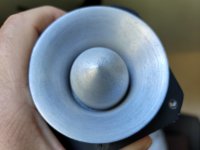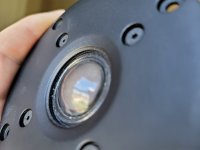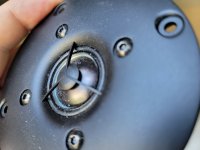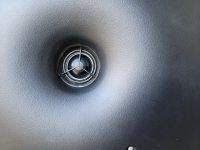I have never boutght the name "phase shield" Piece of plastic tape or cast in front of the center of the dome most likely attenuates axial spl by making an obstruction for wavefront (not blocking) to modify dispersion. Sort of like what a dimple dome (ring radiator) does. Spl attenuation might mean also phase shift , but does is it just semantics?
Delaying axial waves from the tip of the dome like hifijim said - how could that happen? By making those waves to travel longer, past the shield?
SEAS uses a piece of tape on the backside of protection grille in alu tweeter http://seas.no/index.php?option=com...cg&catid=45:seas-prestige-tweeters&Itemid=462,
but not in http://seas.no/index.php?option=com...xt&catid=45:seas-prestige-tweeters&Itemid=462
or smaller diameter models.
What SB26ADC and many Peerless old models have is more like mechanical protection in my eyes.
Delaying axial waves from the tip of the dome like hifijim said - how could that happen? By making those waves to travel longer, past the shield?
SEAS uses a piece of tape on the backside of protection grille in alu tweeter http://seas.no/index.php?option=com...cg&catid=45:seas-prestige-tweeters&Itemid=462,
but not in http://seas.no/index.php?option=com...xt&catid=45:seas-prestige-tweeters&Itemid=462
or smaller diameter models.
What SB26ADC and many Peerless old models have is more like mechanical protection in my eyes.
You might be better off thinking of it as reducing phase cancellation. In the SB drivers it also supresses the ultrasonic breakup peak on axis as seen in hificompass's measurements.

Compare augerpro's waveguides with and without phase shield, you can see that without there is more of a deepening off axis null forming around 16K. The phase sheild smooths this out. So the value depends very much on the driver and any face plate or waveguide to decide if it has any useful value.

Compare augerpro's waveguides with and without phase shield, you can see that without there is more of a deepening off axis null forming around 16K. The phase sheild smooths this out. So the value depends very much on the driver and any face plate or waveguide to decide if it has any useful value.
I think it is more than just attenuation, and I sort of doubt there is much attenuation anyway. At 16k, the wavelength is 21 mm, so half wavelength is 10.5 mm. That is about the height of a typical dome, so when listening on axis, the sound from the center of the dome is 10.5mm closer than the sound from the perimeter, which means we get a cancellation at 16k.I have never boutght the name "phase shield" Piece of plastic tape or cast in front of the center of the dome most likely attenuates axial spl by making an obstruction for wavefront (not blocking) to modify dispersion. Sort of like what a dimple dome (ring radiator) does. Spl attenuation might mean also phase shift , but does is it just semantics?
The small disc in front of the tweeter increases the path length of the sound wave from the center. The trip from the center to the edge of the disc and around adds ~ 10 mm of distance.
Joseph Crowe has a new design up on his website using dual 10" Purifi drivers in a bass horn.
Hello,You might be better off thinking of it as reducing phase cancellation.
It functions much like a phase plug in a compression driver (horn).
For grins a SB26ADC-C000-4 tweeter installed in a VISTON waveguide.
Thanks DT
https://www.diyaudio.com/community/threads/the-elsinore-project-thread.97043/post-7256593
Last edited:
Any hard object in front of a cone/dome will together with the wg/baffle/box shape the wavefront through diffraction. It is not intuitively easy to visualise what the effect is and it very much dependent on the exact geometry and motion. By endless optimisation in FEA simulation it’s possible to find the needle in the haystack to obtain a desired radiation pattern.
The only name that in my view is not correct is to call it a lens. A lens is normally much larger than a wavelength and the effect can be found from its geometry and change of speeds of sound (refraction). Lenses were popular back in old days before FEA since they could be designed from the principles known in optics.
The only name that in my view is not correct is to call it a lens. A lens is normally much larger than a wavelength and the effect can be found from its geometry and change of speeds of sound (refraction). Lenses were popular back in old days before FEA since they could be designed from the principles known in optics.
yes correct. acoustic lenses were built out of meta materials (perforated plates etc) and not glass with data sheets
Any hard object in front of a cone/dome will together with the wg/baffle/box shape the wavefront through diffraction. It is not intuitively easy to visualise what the effect is and it very much dependent on the exact geometry and motion. By endless optimisation in FEA simulation it’s possible to find the needle in the haystack to obtain a desired radiation pattern.
The only name that in my view is not correct is to call it a lens. A lens is normally much larger than a wavelength and the effect can be found from its geometry and change of speeds of sound (refraction). Lenses were popular back in old days before FEA since they could be designed from the principles known in optics. (Bold and Italics by DT)
Hello,
Not looking for a needle in a haystack.
I do this for hobby fun.
Looking for lab exercises on the bench to explore the topics and make some observations and measurements. What can we measure, what can we hear
First start with what is known. I have a wall of books and access to the AES E-Library of papers over the decades.
The coverage angle of drivers vs. frequency shows up in the Olsen acoustics text from 1947. This is all about phase canceling with increasing frequency.
One paper from a couple of generations ago speaks of a Omni directional tweeter made from a parabolic reflector. reflection may be variable to consider.
Some theories speak of drivers as point sources. That seems a little too simple, perhaps visualize a tweeter with 100 plus point sources over a 26mm dia tweeter diaphragm. I can visualize phase canceling from point sources on opposite sides of dome tweeter as a measurement microphone moves off axis.
SPL is measured with microphones calibrated in Pascals (pressure per unit area). No fluid, no pressure. It follows that fluid dynamics (Bernoulli kind of stuff) will be included in the model. There is a lot of discussion of velocity noise in ports and nonlinear compression distortion in sealed enclosures and Compression Drivers / Horns.
So yes I do visualize a section cut through a early JBL ring Bullet Tweeter. I do visualize a section cut through a tweeter attached to a wave guide. I do visualize a dome tweeter forming a phase plug.
See the attached photos:
The tweeter measurements in post 2371 were made with the tweeter and waveguide in photo #4. fyi
Thanks DT




Not sure if i understand what you are saying.
A lot is apparently known, one aspect i have not seen covered , for sure i have not read everything, so excuses my naivity, but is about the boundary effect or layer. In fluid dynamics a well known phenomenon, not yet in audio seen mentioned. And when i see such structures a phase shields it immedeately pops up in my mind.
A lot is apparently known, one aspect i have not seen covered , for sure i have not read everything, so excuses my naivity, but is about the boundary effect or layer. In fluid dynamics a well known phenomenon, not yet in audio seen mentioned. And when i see such structures a phase shields it immedeately pops up in my mind.
I can not remember the precise answer but was told once by Earl Geddes when I laymen-ly brought the topic up that boundary phenomena do not apply to acoustics as they do in fluid dynamics, I think because pressure is constant in fluids and not so in audio.
Well the first time i heard of was early eighties listening to an onken system with horn mid and tweeter, driven with a 2a3 SE amp. While very nice sounding i heard a sofltly high pitch whistle like sound as well. Jean Hiraga explained to me it was the effect of air not moving when in touch with horn walls. So while not the boundary layer with air flowing over a hard surface(car, plane, etc) , there is in case of sound movement being periodical back and forth or something similar.
Btw Those horns were beautifully made wooden horns, pieces of art and craftsmanship.
Btw Those horns were beautifully made wooden horns, pieces of art and craftsmanship.
What Hiraga explained sounds like the visco-thermal effect. All hard surfaces provide cooling of the air as well as friction - both adds losses. Comsol can model this but it requires a very fine mesh around all surfaces. The effect plays a big role in micro acoustics (eg hearing aids) but is irrelevant for larger hifi constructions unless you deliberately have perforated plates etc.
Why do they call it "AC" not alternating Alternating Voltage?
The pressure that microphones measure is Alternating Pressure.
With Alternating Pressure fluid flow is also alternating and depending on amplitude there may be laminar flow, turbulent flow and/or swarms of vortices. Or perhaps all of the above especially in the throat of a wave-guide mounted hard dome tweeter.
Fluid flow causes noise, turbulence causes noise and vortices cause pulsed noise.
I would like to put a calibrated microphone up close to one of those whistling tweeters.
Thanks DT
The pressure that microphones measure is Alternating Pressure.
With Alternating Pressure fluid flow is also alternating and depending on amplitude there may be laminar flow, turbulent flow and/or swarms of vortices. Or perhaps all of the above especially in the throat of a wave-guide mounted hard dome tweeter.
Fluid flow causes noise, turbulence causes noise and vortices cause pulsed noise.
I would like to put a calibrated microphone up close to one of those whistling tweeters.
Thanks DT
thats how wind instruments work. Their harmonics give their character. would not work without a nonlinear effect
A bit of impossibility, was some 40 years ago. It was a multicell wooden horn laquered, beautiful japanese craftsmanship.I would like to put a calibrated microphone up close to one of those whistling tweeters.
Thanks DT
Around the time Michelle Reverchon(present in that session) founded Goldmund, audibility of copper quality and resistor construction quality became apparent, the pc entering our daily lives, L' Audiophile, etc.
Like i said nice memories left , also the time i got children ;-)
Minor technicality: boundary layers (BL) do apply to acoustics but the effects are typically negligible because it takes time for a BL to develop and (FYI, pressures do not have to be constant in fluid dynamics, AKA unsteady flow) don't have time to develop in the pressure/velocities/viscosities of unsteady flows associated with acousics.I can not remember the precise answer but was told once by Earl Geddes when I laymen-ly brought the topic up that boundary phenomena do not apply to acoustics as they do in fluid dynamics, I think because pressure is constant in fluids and not so in audio.
(Of course, this is not true in ports, where the velocities are drastically increases in the ports due to smaller area as compared to the velocities near the surface of the cone. If it's really bad, the flow near the surface goes turbulent and you get all sorts of nasty acoustics even in the upper frequencies since turbulence breaks up "big whirls into little whirls" and little whirls have shorter characteristic time lengths, hence, higher frequencies.)
- Home
- Loudspeakers
- Multi-Way
- Exploring Purifi Woofer Speaker Builds